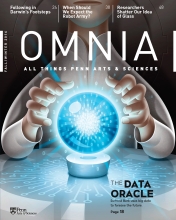The idea that our solar system is one of the multitudes in the heavens is ancient: Giordano Bruno advocated a similar viewpoint in the late 1500s. But, until relatively recently, we had no proof that our solar system wasn’t unique. In the two decades since the discovery of the first “exoplanets,” astronomers have discovered thousands more. We have come to understand not just that planets are common, but also that some of these planets are very different in size and composition from the familiar eight (sorry, Pluto!) orbiting our Sun. Detecting planets that are like Earth—rocky bodies orbiting their host stars in the so-called Habitable Zone, where it is not too hot and not too cold, is a staggering technological challenge. The discovery of Proxima Centauri b by a team led by Dr. Guillem Anglada-Escudé of Queen Mary University in London required a painstaking analysis of more than 15 years of data and a novel take on where galactic prime real estate might be located.
In the absence of a greenhouse effect, the temperature of a planet is determined by the radius and temperature of its host star and the planet-star distance. So, a planet orbiting a big, hot star would have to be far away from the star to maintain a comfortable temperature. Conversely, if the host star were small and cool, then the planet would have to be very close to the star to realize that same temperature. From the point of view of detecting planets, this presents a huge advantage. It is easier to detect planets orbiting small stars and it is easier to detect planets close to their host stars. This small star double whammy is exactly the advantage Anglada-Escudé and collaborators exploited to find Proxima Centauri b. In this case, Proxima Centauri is less than 20 percent of the mass and radius of the Sun, meaning detecting its Earth-mass companion is just within the grasp of our existing technologies.
What would conditions be like on this planet? Could it potentially be suitable for the type of carbon-based life that we are familiar with? These fascinating questions drive our search for Earth-like planets. Inferring the conditions on the surface of a distant planet is hard, particularly without any direct measurements of the planet’s atmosphere. An advanced alien astronomer peering back at Earth with a sophisticated observatory might detect subtle signs of our vibrant ecosystem—like methane and oxygen in our atmosphere and oceans covering significant portions of Earth’s surface. We are a long way from making these types of measurements of Proxima Centauri b, but a new generation of telescopes, including NASA’s James Webb Space Telescope, Hubble’s successor, are an important step in that direction.
Eager to learn much more about this planet in their lifetimes, a group of scientists and engineers convened by billionaires Yuri Milner and Mark Zuckerberg is currently working on plans to send a fleet of miniature space probes to Proxima Centauri b. Together, these “nanocrafts” would beam back data about the planet’s surface. This ambitious project, called Breakthrough Starshot, would take decades—up to 30 years for the miniature craft to reach Proxima Centauri b and almost five years for data to be received back here on Earth. I, for one, think the results will be well worth the wait.
Cullen Blake is an assistant professor of physics and astronomy.




